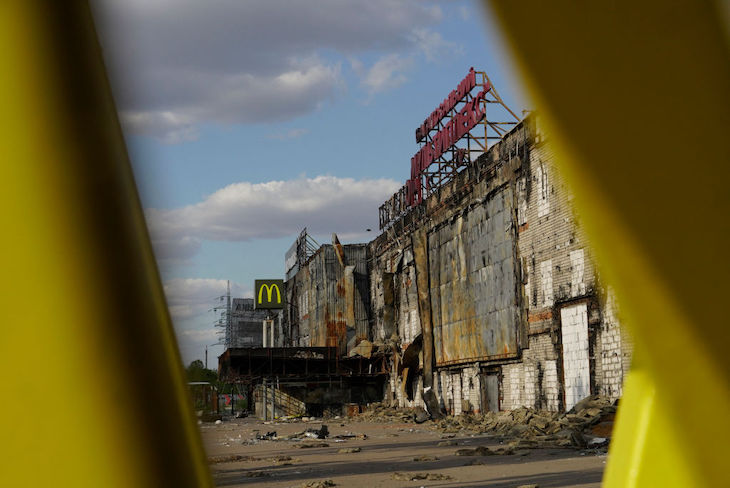Browsing the shelves at Tsum, a supermarket in the centre of Kherson in Ukraine, you could be forgiven for thinking you were in Whole Foods in Kensington. The deli and the grocery are as well stocked and diverse as any in London and, in the patisserie, the smell of freshly baked brioche permeates the air. Every day, people walk the aisles, gathering not only essentials but exotic fruits, kombucha and even Christmas decorations. In many ways, Tsum is emblematic of this city’s resilience in the midst of war. On the upper floors, its windows are either smashed or missing altogether; at street level, its doors are appended with large protective sheets of wood. Yet inside, life goes on much as it did before. Step outside and the booms and crumps of artillery, aerial bombs and grads reverberate constantly across the city. Although its residents can leave at any time, and many already have, Kherson feels very much like a city under siege.
The Kherson region is cut almost in half by the Dnipro river, with Kherson city on its Western bank. From the other, the shelling is ceaseless. Day and night, artillery pounds the city with a relentlessness that feels both random and indifferent. But the Ukrainians too are unrelenting in their own way, doggedly refusing to give in to fear. Between the explosions, life in Kherson persists. Cafes stay open most of the day and hair salons continue to operate unabated, the low hum of hairdryers and the sound of the radio punctuated by the rumble of artillery and occasional rattling of windows.
Kherson wasn’t always like this, the wild dogs once had loving owners
A few blocks from the river, the theatre is staging a production by a local playwright, advertised only by word of mouth. As with much else in Kherson, this is the influence of the fear of being made a target of the Russian artillery. In a basement deep within the building, a hundred or so people gather, huddled together to watch the play in a cellar directly under the boards of the stage above. There is sophisticated lighting and sound design and the show, which would not be out of place on a West End stage, goes on undeterred by the encroaching sound of the war upstairs. There is a sense of stoicism about the whole thing, as actor and audience put themselves at great risk, determined to keep the city’s arts scene going. Life in Kherson is saturated with these instances of intentional normality.
Driving around the city at dusk is a deeply disquieting experience. By 4pm, the streets are empty, the hallmarks of life retreating into dense, squat Soviet era residential blocks that flank wide nineteenth century boulevards. By 5pm, the city is enveloped in darkness, an unsettling silence broken only by the reverberation of nearby explosions and the howling of wild dogs. There are no street lamps here: to light the streets would make targeting infrastructure too easy, and so park and pavement remain dark, illuminated only by moonlight until morning. Entire apartment blocks stand dark and imposing against the night sky, stippled with warm light radiating from the occasional kitchen window. Sporadic silhouettes are the only sign that anyone is still here. The sounds of shelling continue through the night.
Kherson wasn’t always like this, the wild dogs once had loving owners and a haircut was not always a revolutionary act. Before the full-scale invasion, Kherson was a resort city, frequented, in particular, by Russian tourists. As Ukrainian forces eke out a foothold on the far side of the river, encroaching metres at a time on Russian positions, the city itself is made up only of civilians. There is a punitive nature to these attacks that is hard to describe. When the city finally was liberated following nine months of occupation, Ukraine’s president Zelenskyy stood just metres from the supermarket to address the nation. Within minutes of the end of his address, the shelling began. One year on, it has yet to stop. In recent months, the Russians have redoubled their efforts, unleashing an unprecedented amalgam of weaponry upon the city. It is a grinding, inexorable assault, less shock and awe and more a tireless and punishing wearing down of its inhabitants for no ostensible strategic purpose. People here understand that they are the target, that the army on the other side of the river don’t much care what or who they hit – to hit something, anything, is enough.
In Kherson, fear and resilience go hand in hand, inextricably bound by the resolve of those who live here. The makeshift basement theatre, the supermarket, the hair salons and gyms are sanctuaries, not just literally, but in a more profound sense too. Here, normal life is a deliberate act of defiance. The temerity of old and young alike, navigating daily the war torn streets of Kherson in the face of incessant artillery fire is a kind of resistance. It is here in Kherson, as ordinary people defy the extraordinary circumstances thrust upon them, that the unwavering resolve of the human spirit prevails, finding a way through like a sapling from an old oak through a crack in scorched earth.






Comments